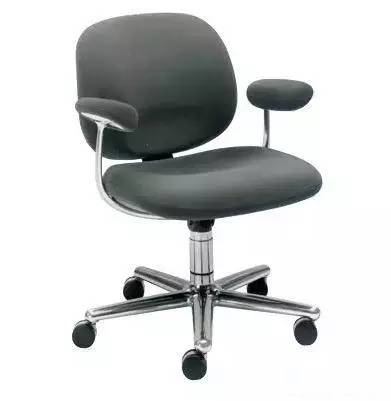Although there were many aesthetically influential office chairs in the early 20th century, it was a low point for ergonomic design. For example, Frank Lloyd Wright, crafted many impressive chairs, but like other designers, he was more interested in chair decoration than ergonomics. In some instances, he did take into account human activity. The 1904 Larkin Building chair was designed for typists. When the typist leans forward, so does the chair.

Due to the poor stability of the chair, which was later called a "suicide chair", Wright defended his design, saying that it required you to have good sitting posture.
The chair he made for the chairman of the company could be rotated and adjust its height, was considered one of the greatest office chairs. The chair, is in the Metropolitan Museum of Art now.

In the 1920s, the idea that sitting comfortably made people lazy was so common that workers in factories sat on benches without backs. At the time, there were increasing complaints about declining productivity and employee illnesses, especially among women workers. So, the company Tan-Sad put on the market a seat that can adjust the height of the backrest.

Ergonomics gradually became popular at this time in the 1950s and 1960s, however, the term had emerged more than 100 years earlier and did not come to the fore until World War II. Studies have shown that after World War II, a lot of jobs required us to sit. The 1958 MAA chair, designed by Herman Miller designer George Nelson, was novel in that its backrest and base tilted independently, creating a new experience for the human body at work.

In the 1970s, industrial designers became interested in ergonomic principles. There are two key iconic American books: Henry Dreyfuss's "Measure of Man" and Niels Diffrient's "Humanscale" illustrate the intricacies of ergonomics.
Rani Lueder, an ergonomist who has been following the chair for decades, believes that the authors of the two books oversimplify in some ways, but that these simplified guidelines help in the development of the chair. Devenritter and designers Wolfgang Mueller and William Stumpf, while implementing these findings, invented the method of using molded polyurethane foam to support the body.

In 1974, modern manufacturing magnate Herman Miller asked Stumpf to use his research to design a office chair. The result of this collaboration was the Ergon Chair, first released in 1976. Although ergonomics experts don't agree with the chair, they don't disagree that it has brought ergonomics to the masses.

The Ergon chair is revolutionary in terms of engineering, but it's not pretty. From 1974 to 1976, Emilio Ambasz and GiancarloPiretti designed the "Chair Chair", which combines engineering and aesthetics and looks like a work of art.

In 1980, office work was the fastest-growing segment of the U.S. job market. That year, Norwegian designers Peter Opsvik and Svein Gusrud came up with an alternative solution to back pain, chronic desk sitting and other health problems: Don't sit, kneel.
The Norwegian Balans G chair, which abandons the traditional right-angled sitting position, uses a forward Angle. The Balans G seat has never been successful. Imitators mass-produced these chairs without seriously considering the design, leading to a steady stream of complaints about knee pain and other problems.

As computers became an essential part of offices in the 1980s, reports of computer-related injuries rose, and many ergonomic chair designs allowed for more postures. In 1985, Jerome Congleton designed the Pos seat, which he described as natural and zero-gravity, and which was also studied by NASA.

In 1994, Herman Miller designers Williams Stumpf and Donald Chadwick designed the Allen Chair, probably the only ergonomic office chair known to the outside world. What's new about the chair is that it supports the lumbar spine, with a shaped cushion implanted in the curved back that can change with the body to adapt to various positions, whether reclining to talk on the phone or leaning forward to type.

There's always a designer who gets drunk during research, spins around, and spits in the face of the world. In 1995, just a year after the Allen chair appeared, Donald Judd, whom Jenny Pinter called an artist and sculptor, enlarged the back and increased the seat's maneuverability to create a straight, box-like chair. When asked about its comfort, he insisted that "straight chairs are best for eating and writing."
Since the introduction of the Allen Chair, there have been many impressive chairs. In the interim, the word ergonomics has become meaningless because there are more and better studies than ever before, but there is still no standard for how to identify whether a chair is ergonomic.
Post time: Jun-16-2023